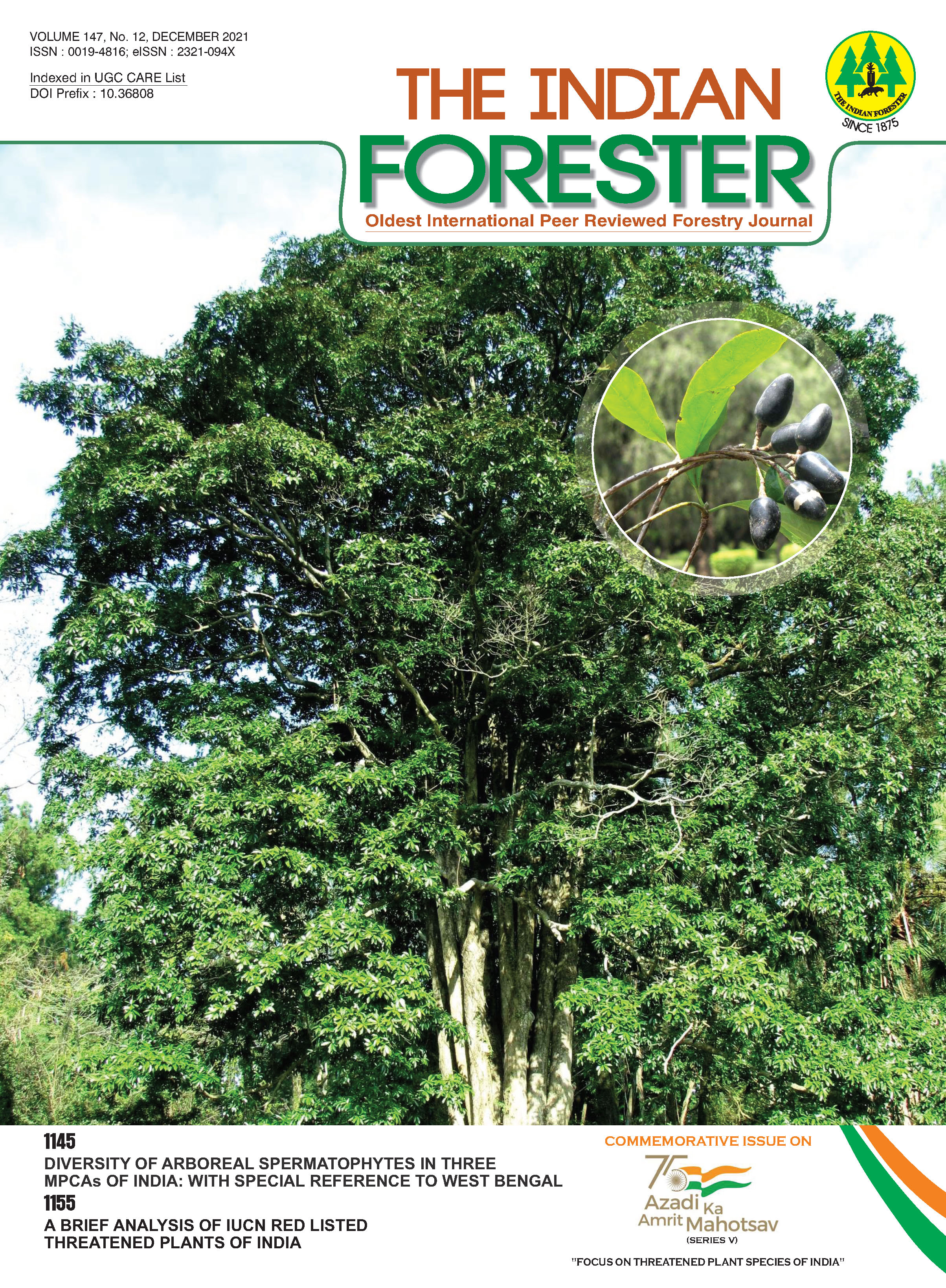New Report of Fusarium flocciferum Causing Rot of Emerging Culm in Dendrocalamus strictus
DOI:
https://doi.org/10.36808/if/2021/v147i12/156507Keywords:
Fusarium flocciferum, Dendrocalamus strictus, Rot of Emerging Culm, Fungicides.Abstract
Fusarium flocciferum causing rot of emerging culms in D. strictus in germplasm bank in the campus of Forest Research Institute, Dehradun is reported as a new record. The disease was found to be affecting new supple emerging culms in the surveyed area. This dreading disease has its most impact in monsoon seasons where there are favourable conditions for the pathogen to flourish and attack the new culms. In vitro fungicidal bioassay was carried out using two systemic and two non-systemic fungicides, out of which Carbendazim was found most effective in complete colony inhibition against the pathogen.References
Bakshi B.K. and Singh S. (1957). Wilt disease of Shisham (Dalbergia sissoo Roxb.). The Indian Forester, 83: 8.
Barnett H.L. and Hunter B.B. (1972). Illustrated Genera of Imperfect Fungi. (III Ed.) Burgess Publishing Co., Minneapolis, 241 p.
Booth C. (1971). The genus Fusarium. Commonwealth Mycological Institute, Kew, Surrey.
Ellis M.B. and Ellis J.P. (1997). Microfungi on Land Plants: An Identification Handbook.
Gilman J.C. (1957). A Manual of Soil Fungi. (II Ed.) The Iowa State Univ. Press. Ames, Iowa, 450.
Goyal A.K., Ghosh P.K., Dubey P.K. and Sen A. (2012). Inventorying Bamboo Biodiversity of North Bengal: A case study. International Journal of Fundamental and Applied Sciences, 1(1): 5-8.
Leslie J.F. and Summerell B.A. (2006). The Fusarium Laboratory Manual. Blackwells: Ames, Iowa, USA.
Miao C.P., Qiao X.G., Zheng Y.K., Chen Y.W., Xu L.H., Guan H.L. and Zhao L.X. (2015). First report of Fusarium flocciferum causing root rot of Sanqi (Panax notoginseng) in Yunnan, China. Plant Dis.
Mohanan C. (1994). Diseases of Bamboo and Rattan in Kerala. KFRI Research Report No. 120: 37 pp.
Mohanan C. (2002). Diseases of Bamboos in Asia: An Illustrated Manual. International Network for Bamboo and Rattan (INBAR), International Network Research Centre.
Rai S.N. and Chauhan K.V.S. (1998). Distribution and growing stock of bamboos in India. Indian forester, 124(2): 89-97.
Helal R.B., Hosan S. and Shamshi S. (2018). Mycoflora Associated with Post-harvest Disease of Papaya (Carica papaya L.) and their Pathogenic Potentiality. Bangladesh Journal of Botany, 47(3): 389-395.
Ridgway R. (1912). Color standards and color nomenclature. Washington, D.C.
Sastri B.N. (1952). The Wealth of India: Raw Materials. III: D-E. Council of Scientific and Industrial Research, New Delhi.
Sinclair J.B. and Dhingra O.D. (1985). Basic Plant Pathology Methods. CRC-Press
Šišić A., Baćanović-Šišić J.H., Schmidt M. and Finckh R. (2019). First report of Fusarium flocciferum causing root rot of pea (Pisum sativum) and Faba Bean (Vicia faba) in Germany. Plant disease (104)1.
Skidmore A.M and Dickenson C.H. (1976). Colony interaction and hyphal interference between Septoria nodorum and phylloplane fungi. Trans Brit. Mycol. Soc., 66(11): 57-64.
Tamolang F.N., Lopez F.R., Semana J.A., Casin R.F. and Espiloy Z.B. (1980). Properties and Utilization of Phillipine Bamboos. In: Bamboo Research in Asia, Lessard, G. and A. Chouinard (Eds.). International Development Research Centre, Canada, pp: 189-200.
Tripathi Y.C., Chand T., Thakur A. and Pathak K.C. (2011). Genetic Improvement and Conservation of Genetic Resources of Some Economically Important Bamboo Species of Northeastern India. Jorhat, Rain Forest Research Institute.
Downloads
Downloads
Published
How to Cite
Issue
Section
License
Unless otherwise stated, copyright or similar rights in all materials presented on the site, including graphical images, are owned by Indian Forester.





